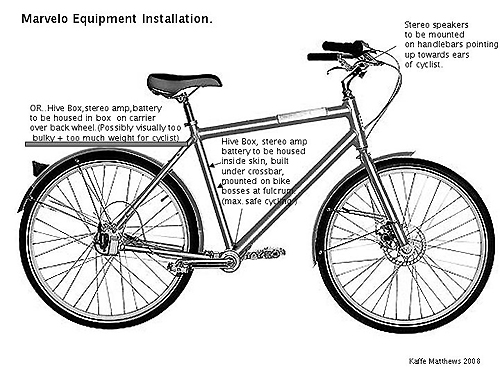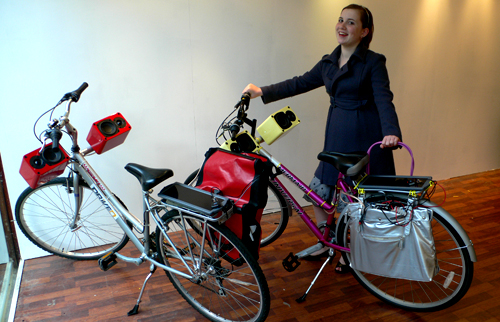History of the Sonic Bike
The sonic bike was first created in 2008 for the Marvelo Project in Folkestone. It grew from Matthews work with bikes, communities, networks and radio in 2003 through the Radio Cycle project. Since then it has developed and evolved into a complex, adaptable instrument that enables many types of performances, interactions, experiences and music to be made.
Marvelo Bike 2008
Design: The Marvelo bikes were second hand bicycles carrying a stereo sound system. The installation of the Marvelo audio system, researched and designed by Kaffe, was enabled through a collaboration with David Cranmer who designed strong steel cross pieces to house the speakers under the handlebars, angled to face the rider. The design to securely carry this kit on moving bikes is as essential as the reliably functioning technology. All hardware was fitted in different handbags for the different bikes on a back carry rack.
Hardware: The Hive Box was the small computer beating at the heart of the Marvelo Project enabled through a collaboration with Alexei Blinov and Wolfgang Hauptfleisch of hive networks. The sound system was powered from a 12V battery converted to 5V for the Hivebox. DETAILS
Software: The Marvelo soft was designed with Kaffe and built by Wolfgang Hauptfleisch for the Hive Box. Peter Edwards developed the Marvelo mapping tool, enabling quadrants to be drawn on digital maps producing GPS grid references which linked chosen sounds to chosen points and areas in the town. This created the first sonic bikes and the dawn of possibilities for bicrophonics.
Composition: The zones could be mapped and layered across any area allowing multiple or single files to play. Three parameters were added to control the way the sound played back. ‘Play’ meant that the sound would play for as long as the bike was in the zone and fade out when the bike left; ‘Loop’ , that the sound would loop whilst the bike was in the zone and stop when the bike left the zone; ‘One shot’, that the sound would play to its end whether the bike stayed in the zone or not.
Project: 5 of these sonic bikes were designed and built for The Marvelo Project, commissioned by the Folkestone Triennial 2008, curated by Andrea Schlieker, from June 14th to September 14th 2008. DETAILS .


Sonic bike v1 (2012 – 201X)
Design: 12 sonic bikes, known as the yellow sonic bike team – were created for The swamp that was, building on the design of the Marvelo bike. The 12 yellow bikes were second hand Ghent city bikes, originally used as hire bikes by students. They were fitted with the same Marvelo handlebar mounted speaker design, with the hardware being housed in a robust black waterproof box screwed on top of the bike’s back carry rack.
Hardware: The small cheap Hivebox was replace by the Beagleboard, GPS receiver, stereo Tangent EVO speakers, Kenwood amplifier and 12v battery. Created by Kaffe, Kurt Van Houtte and Dimitri Van Brandt, this was a more reliable system than the Marvelo Bike.
Software: a new Swamp system, initiated and developed by Wolfgang Hauptfleisch in collaboration with Kaffe was completed and realised by Dave Griffiths , running on the Beagleboard. Find it here https://gitorious.org/swamp-bikeopera.
The mapping tool created by Peter Edwards for sonic bike V1 is still in operation on V2.
Composition:
Project: This system was used on the original yellow sonic bike team , Hai-Art, Finland.
Improvements and their effects:
Sonic Bike V2 (201X – 2015)
Design:
Hardware: uses a Beaglebone Black RevC plus Audio Cape. The sound system uses a Lepai 2020+ amp and unknown US hifi speakers. This system is used on the sonic bikes, Houston.
Software: Dave’s Swamp System (v.1) was used successfully used on the Beaglebone Black RevC in the sonic bike V2.
Composition:
Project:
Improvements and their affects:
Sonic Kids Bike (2014 – current)
Design: The kids bike follows the same design as the sonic bike V2, just fitted to a smaller kids bike, aged XX-XX. Although the kit was heavy, it was still manageable for the kids to ride.
The same hardware, software was used as on the sonic bike V2 and the compositional possibilities were the same.
Project: Built for the 2nd Ward – a bicycle opera project in Houston in 2014. The bikes remain in Houston …XXX
Improvements and their affects:
Sonic Bike V3 (2015 – current)
Design:
Hardware:
Software: Swamp System (v.1) was developed by Tom and Kaffe onto the sonic bike V3 Raspberry Pi2 platform, although it also work on sonic bike V2 Beablebone Black RevC. You can find this code, ‘sonic bike’, on github: https://github.com/anthillsocial/sonic-bike.The software repository contains full instructions for getting up and running on a Beaglebone Black also with information for the Raspberry Pi2.
Francesca developed the Mapping Software to enable multiple maps to be created at once.
Composition:
Project:
Improvements and their affects:
- The new software and hardware was chosen and built by Tom and Kaffe to enable more interaction for the rider in future.
- The Raspberry Pi2 also created a more user friendly system – housing the map and sound files on a USB stick instead of requiring coding, making it accessible for future works with new artists like in the Summer Pedalling Games in 2015.
- Tom and Kaffe also added new parameters to the mapping software in 2015 introducing a changing pitch dependant on the riders direction – an important element for Finding Song Home (2015), and ‘random folders’ to enable chance sound files to play in one location – ideal for small spaces like the square in The Coventry Pedalling Games (2015).
- Francesca’s edits to the Mapping Software enable multiple maps to be created at once and so the Summer Pedalling Games was able to welcome 9 new artists to create 9 separate sound works in the same park in Autumn 2015.
- The speaker bars were altered to create a performing sonic bike that played sound at the passers-by rather than at the rider – with speakers facing down and forwards rather than up and in towards the rider. Developed by Kaffe, Lisa, Artur, Hannah and Stephen for the Animals March in winter 2015, this adaption enabled a performance through central London.
Sonic Trike (2015 – current)
Design: designed and built for the Coventry Pedalling Games by Kaffe and Nick with help from Dan in summer 2015. new design of smaller self powered minirig speakers and therefore a smaller amp free kit box
Hardware:
Software:
Composition:
Project:
Improvements and their affects:
- Enabled small children in the Coventry … as well as small adults in the Summer ….
- The new hardware ..
- The small portable kit enabled Kaffe to transfer it to a touring bike and explore long distance riding through rural landscapes with other bikes. Kaffe was able to experiment with speaker position for the rider or their companions, as well as sound for rural spaces on this London-to-Paris climate change ride in Winter 2015.

